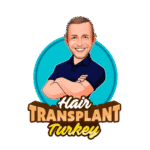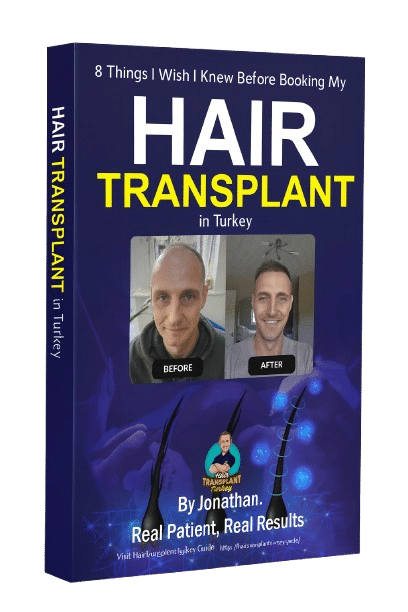When I stepped out of Clinicana Hair Transplant & Esthetic Surgeries in Istanbul, my head was freshly bandaged, and my emotions were mixed — relief that the surgery had gone perfectly, and nervous excitement about what came next: recovery.
Aftercare, I quickly learned, is just as important as the transplant itself. The success of your grafts — and the final look of your new hairline — depends heavily on how you treat your scalp in the days, weeks, and months following surgery.
In this guide, I’ll walk you through exactly what to expect week by week, drawing on both my personal recovery with Clinicana and expert insights from trusted sources like the Mayo Clinic, the ISHRS, and the British Association of Dermatologists.
If you’re just starting your research, I also recommend grabbing my free guide — “8 Things I Wish I Knew Before Booking My Hair Transplant in Turkey”. It covers everything I learned before flying to Istanbul and will help you make the best decision possible.
Why Aftercare Is Just As Important As The Surgery Itself
Getting a hair transplant is a medical procedure, not just a cosmetic one. What happens after the surgery can make or break your results.
Even the most advanced clinic or skilled surgeon can’t guarantee perfect results if the patient neglects the healing process. According to the Mayo Clinic, proper post-op hygiene and scalp protection are key factors in ensuring that newly transplanted grafts take root successfully.
Clinicana took this very seriously — before I even left the clinic, their nurse carefully walked me through washing techniques, how to sleep, and what not to do. They also arranged a free scalp cleaning the following morning, which gave me reassurance that I was on track.
Understanding the why behind each step helps you stay disciplined — and that discipline pays off in visible results later on. Let’s break down exactly how your recovery unfolds from day one.
The First 10 Days After Your Hair Transplant
Day 0–1: Immediate Post-Op Care
The first 24 hours are all about protecting the grafts. Your scalp will feel tight and tender, but that’s normal. Clinicana gave me a bandage over the donor area and a saline spray for the transplanted zone to keep it moist.
You’ll also be prescribed antibiotics and anti-swelling medication. Avoid touching, scratching, or bending over (this can increase pressure in the scalp).
You’ll likely sleep semi-upright with a travel pillow to prevent friction.
The next morning, Clinicana provided a free wash — they demonstrated exactly how to apply foam shampoo and rinse gently. Seeing how careful they were reassured me that every graft was safe.
Day 2–7: Managing Swelling, Sleep, and Scabbing
By day two, swelling might move down toward your forehead — it’s temporary and will fade in a few days. Continue sleeping with your head elevated about 45°.
Clinicana’s washing technique was simple: apply foam shampoo, wait a few minutes, then rinse gently using a cup of lukewarm water. The British Association of Dermatologists stresses that gentle cleansing helps prevent infection and promotes healing.
Scabs will start forming — resist the urge to scratch. Mild itching is actually a sign of recovery as the skin regenerates.
Day 8–10: Scabs Start to Fall Off
This is when you can very gently massage your scalp during washing, if your clinic approves it. I was told to continue daily washing until all scabs were gone.
You’ll probably feel confident enough to go out, but remember: avoid sun exposure and sweating. I wore a loose-fitting hat if I went outside, just as Clinicana advised.
At this stage, you’re entering what’s known as the “shock loss” period — which can be worrying at first, but it’s entirely normal.
Week-by-Week Hair Transplant Recovery Timeline
Week 2 – Shedding (Shock Loss Phase)
Don’t panic if transplanted hairs begin to fall out around week two. This is part of the telogen phase, where follicles temporarily rest before growing new hair. The ISHRS explains that these hairs shed while the root stays intact and begins new growth cycles beneath the skin.
When my shedding began, I remember thinking I’d lost everything — but within a few months, it became clear this was just part of the process.
Week 3–4 – Healing and Waiting
By now, the redness fades and you start looking more “normal.” I was able to resume light exercise and wear hats without worry.
At this point, it’s all about patience — your scalp is healing internally. Clinicana checked in via WhatsApp to ensure things looked good and reminded me to keep using their post-op shampoo.
Month 2–3 – Early Growth Phase
Tiny, thin hairs start to appear. This is when excitement begins. Around my third month, I noticed little sprouts across my new hairline.
It’s also common to see a few pimples or bumps — folliculitis — as new hairs push through. A PubMed study found that over 85% of FUE grafts survive long term when post-op hygiene is maintained properly.
Use mild cleansers, and if anything feels sore, reach out to your clinic.
Month 4–6 – Visible Transformation
This is when you truly start to see progress. By month four, my new hairline was taking shape, and density began improving by the week.
Clinicana’s team had told me to expect this timeline, and they were spot on. Around this time, I started getting compliments from friends who couldn’t quite tell what had changed — only that I looked younger.
You can also resume your normal gym routine, mild styling, and haircuts by now, as long as you’re gentle.
Month 7–12 – Full Growth and Confidence
According to the Mayo Clinic, 10–80% of transplanted hairs typically grow back within three to four months, and full density is achieved around one year.
At month seven, I was honestly amazed. My front hairline looked dense and natural — not like a “hair transplant,” but like my own hair again.
By 12 months, I was styling it normally, using mild shampoo, and occasionally applying a light DHT-blocking foam (on my surgeon’s advice). That’s when I realized the process had truly been worth it.
Essential Aftercare Tips for the Best Results
Here’s what I learned (and what Clinicana reinforced at every stage):
| Do’s | Don’ts |
|---|---|
| Follow your clinic’s washing instructions carefully | Scratch or touch the grafts early on |
| Sleep with your head slightly elevated | Expose your scalp to direct sunlight |
| Use the medicated shampoo provided | Smoke or drink alcohol excessively |
| Stay hydrated and eat protein-rich meals | Wear tight hats or helmets |
| Contact your clinic if anything feels off | Panic about shedding — it’s normal |
Clinicana also scheduled check-ins at one, three, and six months. That ongoing support helped me stay calm and consistent — and that consistency is what gets you the best possible outcome.
Common Mistakes To Avoid During Recovery
Many people unintentionally harm their results by making small mistakes in the first few weeks. From what I’ve seen and researched (including guidance from the European Academy of Dermatology and Venereology), the most common errors are:
- Overwashing or scrubbing too early
- Ignoring clinic instructions
- Using hair oils or products too soon
- Sleeping flat or rubbing the graft area
- Expecting immediate density
I made a point of following Clinicana’s aftercare checklist exactly — and it paid off. My recovery was smooth, with no infection or complications.
When To Contact Your Clinic
Even with perfect care, it’s vital to know when to seek professional advice. You should reach out to your clinic immediately if you experience:
- Excessive swelling after day three
- Persistent bleeding or signs of infection
- Severe pain unrelieved by medication
- Numbness lasting beyond two weeks
I had one moment of worry when a scab looked darker than the rest, but Clinicana reassured me via WhatsApp that it was completely normal. That peace of mind made a huge difference.

Nutrition & Lifestyle for Faster Recovery
Healthy hair growth starts inside your body. During recovery, I made an effort to eat more lean protein, eggs, nuts, and foods rich in biotin, zinc, and iron.
Hydration is also key — water helps nutrients reach your follicles.
For an evidence-based perspective, Harvard Health recommends balanced nutrition as essential for optimal hair health and repair. Avoid smoking, which constricts blood vessels and slows healing, and try to reduce alcohol in the first few weeks.
By supporting your body’s healing processes, you’re directly improving graft survival rates — it’s a win-win.
Long-Term Maintenance: Keeping Your New Hair Healthy
After 6–12 months, the focus shifts to maintaining your results. You can usually introduce treatments like Minoxidil or PRP therapy if your doctor recommends them.
I personally stuck with mild shampoos and regular scalp massages to stimulate circulation. I also made a point of wearing hats or sunscreen outdoors — protecting your scalp from UV exposure is one of the simplest ways to keep grafts healthy.
Clinicana scheduled a one-year review to check progress, and they were genuinely happy with my outcome. Seeing their reaction confirmed I’d chosen the right clinic.
Final Thoughts: Patience, Care, and Confidence
If I could give one piece of advice, it’s this: trust the process. The first few weeks can feel slow, but every day brings you closer to your final result.
The transformation isn’t just physical — it’s deeply personal. I regained confidence, started styling my hair again, and even enjoyed seeing photos of myself for the first time in years.
If you’re considering getting a transplant or are about to start recovery, take your aftercare seriously. It’s the bridge between surgery and satisfaction.
You can follow my full recovery journey, see photos, and access videos documenting every stage by joining my free members area here: https://hairtransplantturkey.guide/.



 Continue with Google
Continue with Google